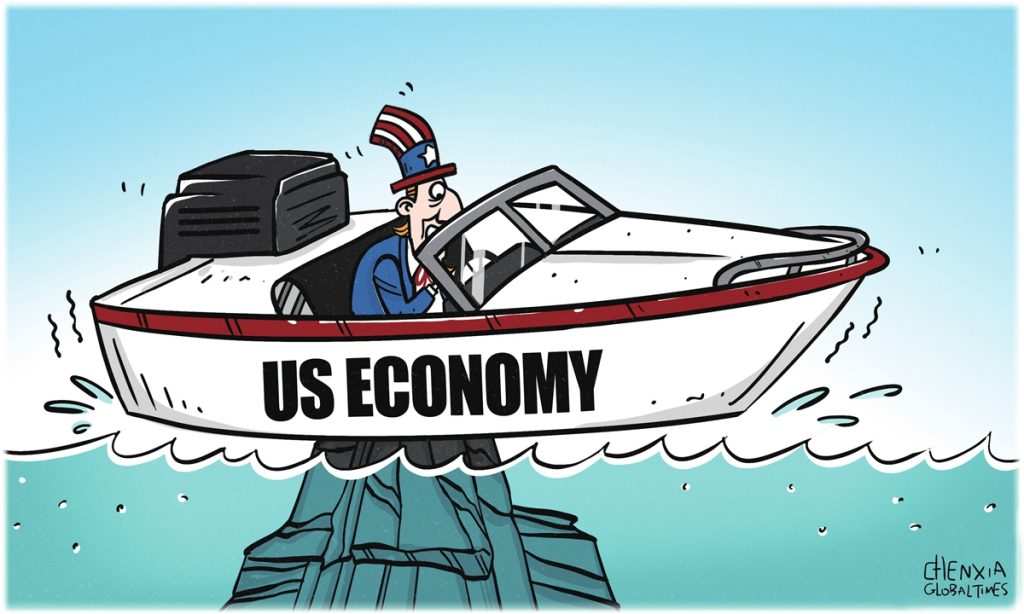Poor data spur fear of US economic downturn

The trade war, initiated by the US against China in 2018 and intensified in the following years, has placed unprecedented external pressure on China's economy. However, this pressure has catalyzed China's economic transformation and market diversification efforts.
Beijing's strategic pivot to expand external markets and extend its supply chains has rapidly reduced its overreliance on the US market. This adjustment has enhanced China's economic resilience and positioned it more favorably within the global financial landscape.
As the US economy shows signs of slowing and the specter of recession looms large, China's economy - despite its challenges - displays remarkable stability. This contrast underscores the effectiveness of China's recent economic adjustments and its increased adaptability.
The US Department of Labor on Thursday released data showing that initial claims for unemployment benefits rose to 249,000 the week before, topping analyst forecasts and reaching the highest level since August of 2023. New purchasing managers data also showed that manufacturers are weakening as they grapple with higher interest rates. US stocks dived immediately as investors fretted over signs of US economic slowdown. The S&P 500 tumbled 76 points, or 1.3 percent, while the Dow Jones Industrial Average tumbled roughly 1.2 percent. The Nasdaq Composite was down even more sharply, sliding 2.3 percent.
The cyclical nature of the US economy raises critical questions: Will this downturn arrive sooner and hit harder than previous downturns?
The US strategy of decoupling from China and reshoring industries was conceived during an economic upswing, along with pandemic-era stimulus measures. As the positive effects of these policies wane, the US economic slowdown is beginning to reverberate globally.
As the world's largest consumer market, US economic fluctuations significantly impact emerging economies. The recent US push for decoupling from China has left many emerging economies more dependent on US exports, making them vulnerable to declining US demand.
Manufacturing exports from countries like Vietnam, Mexico, Bangladesh, the Philippines and India may face shrinking external demand. These countries may need help in maintaining stable economic growth and more resources for industrial upgrading and technological innovation.
Compared to China, these emerging markets often need more foundation for long-term social stability. They may face more significant social tensions and political risks, potentially impacting economic development, labor force improvement and sustained foreign investment.
A US economic downturn could significantly reduce global investors' risk appetite, leading to capital flight from emerging markets. This could exacerbate economic difficulties in these countries, potentially sparking a chain reaction of currency volatility and rising debt risks.
Domestically, the US faces tightening job markets and growing social tensions. Rising unemployment and income inequality may become the primary focus for the US government, potentially diverting attention and resources from global supply chain restructuring efforts.
Economic hardship often breeds protectionism. Based on past trade experiences, we may see more trade barriers, subsidy policies and localization requirements, potentially hindering normal trade relations between emerging markets and the US.
Should the US economic downturn evolve into a global crisis akin to 2008 financial crisis, these emerging markets may need more China's financial resilience and policy flexibility to weather the economic storm effectively as they could face severe economic crises, social unrest and political instability.
Given its economic challenges, Washington's political will and financial resources to continue pushing for decoupling from China remain uncertain. While unlikely to abandon its China strategy entirely, the US may be forced to reassess its global approach, potentially softening its stance on implementation.
In this shifting landscape, China's economic adjustments and export diversification strategy appear increasingly prescient, potentially offering a buffer against the impending global economic turbulence.